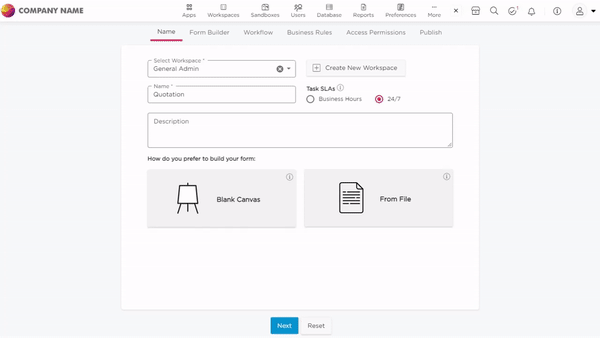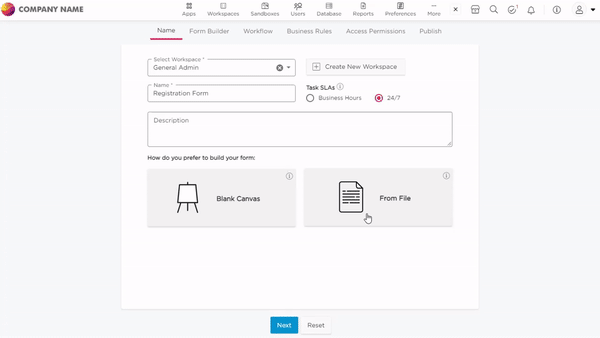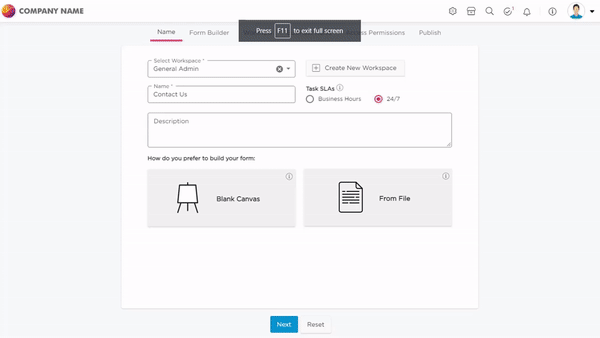¶ An overview of creating app-forms using Excel, PDF, images, and links
No code transformed the way apps are built and processes are automated. Building an application in the traditional terms takes more than 120 days, or 4 months. With no coding platform such as Quixy, anyone can build an app in hours.
It is estimated that more than 50% of the app building process on the Quixy platform is spent on building or creating the form. The Snap to App feature reduces the form-building process by 60% (based on the complexity of the app you are trying to create).
¶ About the Snap-to-App feature
The primary goal of this feature is to drastically reduce the time required to build a form from hours to minutes.
The image below depicts a typical example of a form.

¶ Use Snap-to-App
You can use this feature to create a form in the Create App flow.
Instead of building a form from scratch, you can now upload files such as excel, PDF, images, or provide links (Image URLs) for the platform to process the file and present the fields/elements. Once the file is processed, the resultant fields are presented as a preview for quick edits before the form can be finalized, i.e., human-in-the-loop to ensure necessary corrections are made.

¶ How to Configure?
- On the Quixy dashboard page, click on the Admin Menu -> Apps -> Create App.

- The Platform will redirect you to the first step of the app creation process, i.e., the Name Step.
- Provide a name for the app, and select your preference to build the app-form: From File.

- Platform will display a Choose a file pop-up with four file option (Excel, PDF, Image, and Link) using which you can upload your required file to convert it into an app-form.

TIP
Moving forward, this article will guide you on how to use all four file options to create app-forms. Use the links to directly navigate to options like PDF, Image, Link.Your content goes here.
¶ 1. Excel
- Select the excel option from the pop-up, and you will have the option to download a sample excel sheet (since the platform will accept only a definitive format). Download the excel sheet to understand the format and you need to upload the excel file in the same format in-order to avoid any discrepancies.

- Open the downloaded Excel. You will find some sample data in the downloaded excel file for your reference, and you can follow the same format and replace the sample data with the data that you require. i.e., the Element Types, Label Name, Fields Name, etc. Refer to the image below.

NOTE
The difference that you will observe while creating an app using excel compared to creating an app from scratch is that, while using excel, you can define the sections, element types, field names, and a couple of element properties like hidden fields and required in the excel itself rather than configuring manually.
- Once you make changes in the excel according to your requirements, you need to save the excel and upload the same excel into Quixy to generate an app-form.

- Once you upload the file, click on Next.

- The platform will automatically create an app-form according to the data provided in the uploaded excel, and it will navigate you to the form builder page where you will notice all the data capturing fields. Refer to the image below.
NOTE
When you upload an image of an external form, the system will intelligently detect the width of each form element. This detection determines the optimal cell occupancy for each element within the resulting Quixy form.

¶ 2. PDF
In any typical organization, forms exist in PDF format. These forms may include application forms, grievance forms, feedback forms, etc.
PDFs are very versatile documents. Any image can be converted to PDF as well. In this respect, you may have your forms in the PDF format, which can be categorized into 3 distinct types: digital forms, paper-based forms, and napkin sketches/hand-drawn forms.
a. Digital Forms: Forms that closely resemble online forms, such as retail application forms, employee registration forms, student registration forms, etc. The intent of these forms is for the users to fill in the details right into the file directly.

b. Paper-based forms: These are non-digital forms that most enterprises wish to digitize. Examples include loan application forms, asset registration forms, feedback forms, etc., which can be scanned and converted into PDFs.

c. Hand-run forms: These are napkin sketches that business users prepare to visualize the application. This is a very quick and efficient way to share ideas with the other team members. How do we convert this to PDF? Snap a picture of the sketch and convert it to PDF.

Now that you have got an understanding of what types of PDF files you can use, let us see how the PDF option works.
- Select the PDF option in Choose a file pop-up, as shown below.

- Upload the PDF file, and then click Next.
- Now, allow the platform to process the uploaded file and provide you with the output in the form of an Express Form Creator pop-up in which you can find all the data-capturing fields.
- You will have full control over the fields to make the required changes as shown below, and finally save the fields.
- The Platform will navigate you to the Form Builder page where you will find all the fields that you may have finalized on the Preview screen. On the form builder screen, you will now have the provision to make further needed updates to the properties of the identified fields.

¶ 3. File Type: Image
The IMAGE & PDF options are similar in functionality except that you must use only Image files here; otherwise, everything is same, even the file types you use (Digital Forms, Paper based forms, Hand-run forms). Refer to the GIF below.

¶ 4. File Type: Link
Many a time, you may find a form online (in the image search) that suits your requirement. With Link as an option, you can add the link of the online image for processing. Quixy would download the image or PDF in the background and process the file to present the preview of fields identified.
